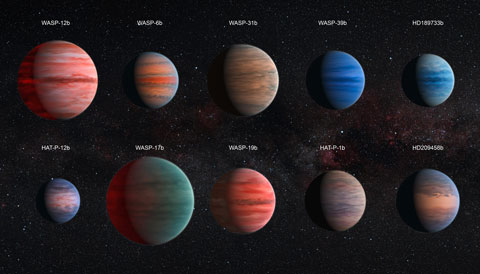Hubble Peers Inside Exoplanets’ Atmospheres
Astronomers studying hot Jupiter exoplanets revealed when and how clouds form on these alien worlds.

An artist's conception shows the ten hot Jupiters studied by Sing and colleagues, drawn to scale. HAT-P-12b, the smallest of them, is approximately the size of Jupiter, while WASP-17b, the largest planet in the sample, is almost twice the size.
ESA / Hubble & NASA
ESA / Hubble & NASA
In the medical field, you generally can’t trust a study until scientists have collected hundreds, sometimes even thousands of subjects. But astronomy is a different kettle of fish.
A paper published online in Nature on December 14th (full article here) contained an analysis of 10 hot Jupiter atmospheres — and that makes it the most comprehensive study on this subject to date. The results have led to some deep insights into planetary atmospheres.
Peering into Hot Jupiters
In these extreme systems, giant planets ranging from a third to 1.5 times Jupiter’s mass orbit their suns in a matter of days. They’re often tidally locked like the Moon, showing just one face to their parent star. Their close orbits expose them to extreme radiation, with temperatures climbing to thousands of degrees, and the differences between dayside and nightside can initiate furious winds.
Astronomers can’t observe these planets directly — they’re too close to their parent star. So they resort to a roundabout way of peering into their atmospheres. They watch the starlight dim as the planet passes in front of its star, a dimming that depends on the wavelength they’re observing. If a planet absorbs radiation at a wavelength of, say, 1.4 microns due to the presence of water in its atmosphere, it will appear bigger at that wavelength, and its transit will make a deeper ditch in the starlight.
So if astronomers measure the size of a planet’s silhouette at a range of wavelengths, they’ll get its spectrum. The video below demonstrates the technique:
Where’s the Water?
A couple years ago, some puzzling results began appearing from this sort of study: hot Jupiters appeared to contain less water in their atmospheres than expected. Was this because the systems lacked water to begin with? Though this possibility was viable, it was less popular because of the problems it caused for planet formation scenarios. Instead, astronomers tended to point to heavy clouds or a Titan-like haze that might block water’s signature.
David Sing (University of Exeter, UK) and colleagues provided the definitive answer when they compared 10 hot Jupiters in visible and near-infrared light with data from the Hubble and Spitzer Space Telescopes. For each hot Jupiter lacking water, they also found spectral signatures of clouds or haze.
"Our results suggest it's simply clouds hiding the water from prying eyes, and we therefore rule out dry, hot Jupiters," coauthor Jonathan Fortney (University of California, Santa Cruz) said in a NASA press release.
"More than that, [the study] also gives a guideline to assess which atmospheres are clear," says Laura Kreidberg (University of Chicago), who was not involved in the study. Clouds have foiled astronomers' application of the transit spectroscopy method in the past. "This [new guideline] will help us weed out cloudy planets and target clear atmospheres to measure their composition and climate."
Chance of Clouds
Though the result was expected, since astronomers had suspected clouds were the culprit behind the missing water mystery, it also upset an understanding astronomers had about clouds. In brown dwarfs, failed stars many times more massive than hot Jupiters, cloud formation depends on temperature. But despite previous indications, it looks like that rule isn’t holding true for hot Jupiters: the coolest planets in this study are just as likely to have clouds as the hottest.
Sing’s team suggests that hot Jupiters straddle the line between clear and cloudy: the parent stars’ strong radiation pushes their atmospheres to the edge of the pressure and temperatures combinations that are friendly to clouds. So even a small shift in temperature might either generate clouds or push them down into the atmosphere and out of observable range.
"The paper is also a great prelude to the results we can expect from future observing facilities like the James Webb Space Telescope," Kreidberg points out. JWST will be crucial to studying nearby planets found with new planet-hunting satellites such as TESS and PLATO. "Planets are complicated beasts and it will take all of our ingenuity to figure them out!"
No comments:
Post a Comment